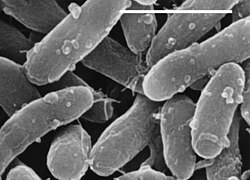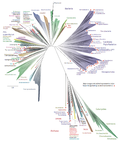Polyphosphate-accumulating organisms (PAOs) are a group of microorganisms that, under certain conditions, facilitate the removal of large amounts of phosphorus...
23 KB (2,418 words) - 00:38, 20 June 2025
these conditions a group of heterotrophic bacteria, called polyphosphate-accumulating organisms (PAO) are selectively enriched in the bacterial community...
4 KB (428 words) - 22:59, 25 May 2025
performing enhanced biological phosphorus removal and is a polyphosphate-accumulating organism. There are currently no cultured representatives, however...
2 KB (110 words) - 08:51, 25 February 2021
(anoxic compartment). Moreover, the organisms used for the phosphorus uptake (Polyphosphate Accumulating Organisms) are more efficient under anoxic conditions...
34 KB (4,471 words) - 00:17, 6 July 2025
that favour slow growing organisms such as PAOs (polyphosphate accumulating organisms) and GAOs (glycogen accumulating organisms). Another key part of granulation...
3 KB (318 words) - 16:51, 26 May 2025
performing enhanced biological phosphorus removal (EBPR) and is a polyphosphate-accumulating organism. The role of CAP in EBPR was elucidated using culture-independent...
9 KB (1,123 words) - 07:41, 11 March 2022
a new Enhanced Bio-Phosphorus Removal plant, which uses polyphosphate-accumulating organisms rather than chemicals to remove phosphates from the effluent...
27 KB (3,276 words) - 18:00, 30 June 2025
Gemmatimonas aurantiaca is a Gram-negative, aerobic, polyphosphate-accumulating micro-organism. It is a Gram-negative, rod-shaped aerobe, with type strain...
2 KB (213 words) - 01:37, 29 April 2022
process, specific bacteria, called polyphosphate-accumulating organisms (PAOs), are selectively enriched and accumulate large quantities of phosphorus within...
80 KB (11,368 words) - 01:58, 6 July 2025
that favour slow growing organisms such as PAOs (polyphosphate accumulating organisms) and GAOs (glycogen accumulating organisms). Another key part of granulation...
26 KB (4,052 words) - 01:58, 6 July 2025
Exopolyphosphatase (redirect from Polyphosphate phosphohydrolase)
Polyphosphate is found in all living organisms and plays an essential role in the organisms survival. In bacteria, polyphosphate is used to store energy to replace...
16 KB (1,882 words) - 05:05, 13 July 2025
a type of polyolefin made from alpha-olefin monomer(s) Polyphosphate-accumulating organism Pao (袍), an element of Han Chinese clothing Pão de queijo...
3 KB (432 words) - 14:13, 20 January 2024
Beggiatoa (section Interactions with other organisms)
in nitrogen-limited coastal waters. Beggiatoa can also accumulate phosphorus as polyphosphate, which it subsequently releases as phosphate under anoxic...
40 KB (4,908 words) - 11:52, 15 July 2025
Bacteria (section Interactions with other organisms)
Bacteria (/bækˈtɪəriə/ ; sg.: bacterium) are ubiquitous, mostly free-living organisms often consisting of one biological cell. They constitute a large domain...
153 KB (16,235 words) - 16:00, 13 July 2025
more (p)ppGpp and this would be one of the reasons that it accumulates more polyphosphate. Adams DG, Phillips DO, Nichols JM, Carr NG (September 1977)...
17 KB (1,971 words) - 00:43, 16 June 2025
almost all other oxygen-tolerant cells, this organism accumulates millimolar quantities of manganese polyphosphate. Manganese is also used by L. plantarum...
22 KB (2,379 words) - 01:36, 2 June 2025
probably the most numerous taxon to have ever existed on Earth and the first organisms known to have produced oxygen, having appeared in the middle Archean eon...
185 KB (18,379 words) - 19:16, 14 July 2025
present per N, organisms experience a faster growth rate. As this ratio increases, it is harder for organisms to grow. One example of organism response to...
48 KB (5,417 words) - 10:33, 12 July 2025
in 1975 by Richard Blakemore, this alignment is believed to aid these organisms in reaching regions of optimal oxygen concentration. To perform this task...
39 KB (4,843 words) - 14:33, 24 May 2025
Polyphosphate forms calcium-rich nanoparticles in vivo, which accumulate on platelets and activate FXII. The regulation of platelet polyphosphates is...
25 KB (3,097 words) - 07:08, 11 July 2025
aurantiaca gen. nov., sp. nov., a gram-negative, aerobic, polyphosphate-accumulating micro-organism, the first cultured representative of the new bacterial...
12 KB (1,035 words) - 06:23, 19 June 2025
currently under study, from simplistic organisms including sponges and ctenophores to more complex organisms such as sea squirts and sharks. The relationship...
134 KB (11,934 words) - 20:28, 10 June 2025
ammonium polyphosphate (APP), aluminium diethyl phosphinate (Alpi), aluminium hydroxide (ATH), magnesium hydroxide (MDH), melamine polyphosphate (MPP),...
84 KB (9,494 words) - 11:42, 11 July 2025
cells. Additional energy conserving inclusions are PHB granules and polyphosphates. When both nitrite and organic substances are present, cells can exhibit...
23 KB (2,595 words) - 08:13, 18 June 2025
the organisms enter the nose. Acanthamoeba also can spread through hot springs, according to the US Centers for Disease Control - The organisms enter...
53 KB (6,212 words) - 08:07, 24 June 2025
Sulfolobus metallicus (section Polyphosphate)
model organism to study the mechanism of metal transport using polyphosphate because this archaea has a higher capacity to accumulate polyphosphate than...
16 KB (1,727 words) - 17:11, 10 January 2024
aurantiaca gen. nov., sp. nov., a Gram-negative, aerobic, polyphosphate-accumulating micro-organism, the first cultured representative of the new bacterial...
68 KB (5,404 words) - 19:54, 14 July 2025
will also filament as a result of a tendency to accumulate phosphate in the form of polyphosphate, which can chelate metal cofactors needed by division...
19 KB (2,064 words) - 19:24, 18 June 2025
etc. Phosphorus from the wastewaters is conventionally recovered as polyphosphate granules, Fe-P or struvite by bacteria. Cusick et al. achieved struvite...
39 KB (5,440 words) - 01:28, 16 November 2022
reconstruction identifies the evolutionary basis for trait acquisition in polyphosphate accumulating bacteria". The ISME Journal. 10 (12): 2931–2945. Bibcode:2016ISMEJ...
114 KB (13,039 words) - 09:42, 27 May 2025




















